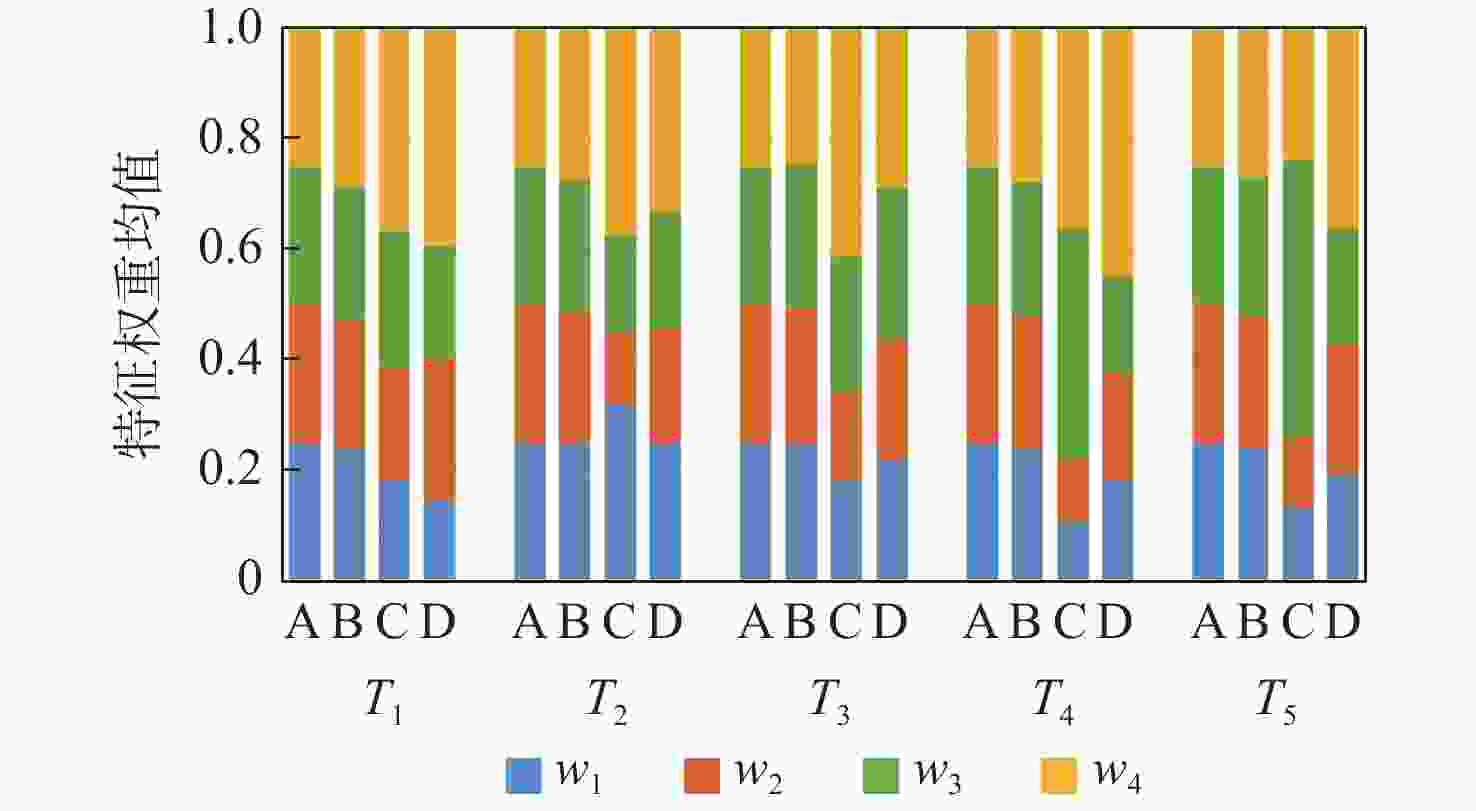-
摘要:
针对模糊特征的目标识别问题,提出了一种结合模糊建模和改进CRITIC方法的相对熵识别方法。计算多个时刻观测值的统计特征,通过模糊建模将观测值转化为模糊数;基于模糊数距离测度,定义并计算目标特征值和观测值之间的相似度;对CRITIC方法进行改进,提出一种目标特征客观权重的求解方法;根据相似度和特征权重,使用相对熵排序法得到识别结果。仿真结果显示:模糊特征能够更好地体现识别中的不确定性,所提方法对模糊特征的目标识别率高,实时性和鲁棒性好,具有一定的应用价值。
Abstract:A relative entropy method combining fuzzy modeling and improved CRITIC was presented to recognize targets with fuzzy features. The observed values from multiple times were converted into fuzzy numbers through fuzzy modeling based on the statistical characteristics of multiple sets of the observed values. As a result of measuring the distance between the fuzzy numbers, similarities between the values of the target feature and the observed values were determined. The improved CRITIC was proposed to calculate the objective weights of the target features. According to the feature weights and the similarities between the target feature values and the observed values, the recognition result was obtained by the relative entropy evaluation method. The simulation results indicate that the uncertainty in target recognition is better reflected by the fuzzy features, and the proposed method has a high target recognition rate for the target with fuzzy features with good real-time and robustness, which has a certain application value.
-
Key words:
- relative entropy /
- fuzzy number /
- CRITIC /
- multiple attribute decision making /
- target recognition
-
表 1 空中目标模糊数据库
Table 1. Fuzzy database of air targets
目标 F1/(km·h−1) F2/(m·s−2) F3/km F4/GHz T1 (800,900,1050) (0,1.2,3.0) (10.0,12.5,15.0) (13.05,13.20,13.35) T2 (580,700,800) (0,0.7,2.8) (10.0,12.0,14.0) (14.50,14.70,14.90) T3 (400,600,955) (0,0.5,2.0) (7.5,9.0,12.0) (2.30,2.40,2.50) T4 (905,1200,1800) (0,4.0,8.0) (13.0,16.0,18.0) (9.25,9.35,9.45) T5 (710,1100,1500) (0,3.2,6.0) (8.0,13.0,14.0) (9.20,9.30,9.40) 表 2 不同相似度指标下的识别率
Table 2. Recognition rate of different similarity metrics
M 识别率/% 似然
函数法顶点法 L2-metric
距离法1.0 73.43 99.58 99.77 1.1 70.80 98.70 99.08 1.2 67.78 97.22 97.76 表 3 不同权重计算方法下的识别率
Table 3. Recognition rate of different weight calculation
% 权重
计算识别率 等权重法 96.90 熵权法 96.96 CRITIC
方法96.35 改进CRITIC
方法97.92 表 4 不同多属性决策方法下的识别率
Table 4. Recognition rate of different multiple attribute decision making methods
% 方法 识别率 TOPSIS 97.62 灰色关联TOPSIS 95.35 相对熵排序法 97.94 表 5 不同观测值组数下的识别率
Table 5. Recognition rate of different sets of observations
N 识别率/% N 识别率/% 2 94.42 13 99.80 3 95.93 14 99.87 4 97.05 15 99.91 5 97.86 16 99.91 6 98.34 17 99.94 7 98.82 18 99.96 8 99.17 19 99.96 9 99.39 20 99.97 10 99.60 21 99.98 11 99.70 22 99.98 12 99.75 表 6 不同目标数量和观测值组数下的运行时间
Table 6. Running time of different numbers of targets and sets of observations
N 运行时间/ms nT=2 nT=3 nT=4 nT=5 2 0.337 0.375 0.407 0.447 3 0.333 0.375 0.410 0.447 4 0.332 0.370 0.408 0.449 5 0.330 0.377 0.410 0.450 6 0.333 0.374 0.409 0.450 7 0.334 0.381 0.409 0.447 8 0.334 0.377 0.413 0.446 表 7 不同特征数量和观测值组数下的运行时间
Table 7. Running time of different numbers of features and sets of observations
N 运行时间/ms nF=1 nF=2 nF=3 nF=4 2 0.094 0.169 0.222 0.270 3 0.091 0.167 0.218 0.271 4 0.093 0.167 0.218 0.271 5 0.089 0.168 0.223 0.273 6 0.091 0.166 0.214 0.268 7 0.093 0.167 0.221 0.274 8 0.094 0.166 0.215 0.272 表 8 不同观测值组数下的虚警率
Table 8. False alarm rate of different sets of observations
N 虚警率/% 平均
虚警率/%T1 T2 T3 T4 T5 2 5.00 6.70 6.17 6.58 6.39 6.17 3 3.71 5.19 5.32 5.45 5.39 5.01 4 2.93 4.76 4.57 4.41 4.26 4.19 5 2.37 4.11 4.06 3.89 3.99 3.68 6 1.48 3.37 3.66 3.48 3.49 3.10 7 1.05 3.23 2.97 3.14 3.50 2.78 8 0.74 2.76 2.58 2.76 2.65 2.30 表 9 只存在奇异点时不同观测值组数下的识别率
Table 9. Recognition rate with different sets of observations when only outliers exist
N 识别率/% M=1.2 M=1.4 M=1.6 M=1.8 M=2.0 2 40.53 36.60 32.04 28.40 24.11 3 40.18 34.59 32.40 29.62 26.36 4 44.90 41.20 37.69 34.22 28.18 5 47.78 42.54 38.31 34.07 30.01 6 49.88 43.46 39.95 36.44 31.39 7 49.62 45.03 41.23 36.58 31.62 8 51.74 45.28 41.10 37.15 32.04 表 10 同时存在正常数据和奇异点时不同观测值组数下的识别率
Table 10. Recognition rate of different sets of observations with both normal data and outliers
N 识别率/% M=1.0 M=1.2 M=1.4 M=1.6 M=1.8 M=2.0 2 97.73 93.94 89.10 82.67 75.52 68.64 3 98.85 94.91 89.22 81.03 72.15 63.47 4 99.41 95.72 89.30 80.19 69.58 60.31 5 99.71 96.51 89.81 79.31 67.55 57.57 6 99.83 97.04 89.97 78.46 65.55 55.27 7 99.91 97.18 90.43 77.77 64.09 55.73 8 99.95 97.52 90.86 76.83 62.86 52.68 表 11 不同奇异点偏离程度下的识别率
Table 11. Recognition rate of different deviation degrees of outliers
N 识别率/% M=1.2 M=1.4 M=1.6 M=1.8 M=2.0 2 40.65 36.97 32.30 28.24 24.22 3 39.95 34.66 32.38 29.57 26.94 4 44.90 41.59 37.36 33.93 28.34 5 47.47 42.39 38.47 34.49 29.80 6 49.67 43.45 40.09 35.87 31.28 7 50.29 45.06 41.03 36.30 31.61 8 51.62 45.48 40.99 37.29 31.88 -
[1] LI Y B, CHEN J E, YE F, et al. The improvement of DS evidence theory and its application in IR/MMW target recognition[J]. Journal of Sensors, 2016, 2016: 1-15. [2] FU Y J, SUN K F. Solution to evidence conflict in target recognition[C]//Proceedinhgs of the Joint International Advanced Engineering and Technology Research Conference. Paris: Atlantis Press, 2018, 137: 302-306. [3] 孟光磊, 龚光红. 证据源权重的计算及其在证据融合中的应用[J]. 北京航空航天大学学报, 2010, 36(11): 1365-1368. doi: 10.13700/j.bh.1001-5965.2010.11.027MENG G L, GONG G H. Weight coefficients calculation for evidence sources and it’s application in evidences fusion[J]. Journal of Beijing University of Aeronautics and Astronautics, 2010, 36(11): 1365-1368(in Chinese). doi: 10.13700/j.bh.1001-5965.2010.11.027 [4] 陆峰, 徐友春, 李永乐, 等. 基于DSmT理论的多视角融合目标检测识别[J]. 机器人, 2018, 40(5): 723-733. doi: 10.13973/j.cnki.robot.170507LU F, XU Y C, LI Y L, et al. Multi-perspective fusion for object detection and recognition based on DSmT[J]. Robot, 2018, 40(5): 723-733(in Chinese). doi: 10.13973/j.cnki.robot.170507 [5] FAN X M, HU S L, HE J B. A dynamic selection ensemble method for target recognition based on clustering and randomized reference classifier[J]. International Journal of Machine Learning and Cybernetics, 2019, 10(3): 515-525. doi: 10.1007/s13042-017-0732-2 [6] DING J, CHEN B, LIU H W, et al. Convolutional neural network with data augmentation for SAR target recognition[J]. IEEE Geoscience & Remote Sensing Letters, 2016, 13(3): 364-368. [7] YANG H H, GAN A Q, CHEN H L, et al. Underwater acoustic target recognition using SVM ensemble via weighted sample and feature selection[C]//Proceedings of the 13th International Bhurban Conference on Applied Sciences and Technology. Piscataway: IEEE Press, 2016: 522-527. [8] 雒建卫, 姜志国. 基于背景属性的目标识别[J]. 北京航空航天大学学报, 2014, 40(12): 1702-1706. doi: 10.13700/j.bh.1001-5965.2013.0750LUO J W, JIANG Z G. Object recognition based on background attributes[J]. Journal of Beijing University of Aeronautics and Astronautics, 2014, 40(12): 1702-1706(in Chinese). doi: 10.13700/j.bh.1001-5965.2013.0750 [9] 万树平. 多传感器目标识别的理想点法[J]. 传感器与微系统, 2008, 27(9): 50-51. doi: 10.3969/j.issn.1000-9787.2008.09.016WAN S P. Method based on ideal point for multi-sensor target recognition[J]. Transducer and Microsystem Technologies, 2008, 27(9): 50-51(in Chinese). doi: 10.3969/j.issn.1000-9787.2008.09.016 [10] 万树平. 机器人非视觉多传感器信息融合的TOPSIS法[J]. 计算机工程与应用, 2009, 45(7): 209-211. doi: 10.3778/j.issn.1002-8331.2009.07.064WAN S P. TOPSIS method for robot non-vision multi-sensor information fusion[J]. Computer Engineering and Applications, 2009, 45(7): 209-211(in Chinese). doi: 10.3778/j.issn.1002-8331.2009.07.064 [11] ZHENG H. Multi-sensor target recognition using VIKOR combined with G1 method[J]. Applied Mechanics and Materials, 2014, 707: 321-324. doi: 10.4028/www.scientific.net/AMM.707.321 [12] REN H P, QIU X H. Relative entropy evaluation method for multi-sensor target recognition[J]. International Journal of Control and Automation, 2016, 9(6): 319-326. doi: 10.14257/ijca.2016.9.6.30 [13] REN H P, YANG L W. Multi-sensor target recognition based on VIKOR[J]. Sensors and Transducers, 2013, 156(9): 130-135. [14] 阳连武, 冷建华, 黄义强. 多传感器目标识别的灰色关联TOPSIS法[J]. 宜春学院学报, 2016, 38(3): 6-8.YANG L W, LENG J H, HUANG Y Q. Multi-sensor target recognition based on TOPSIS method combining with grey relation analysis[J]. Journal of Yichun University, 2016, 38(3): 6-8(in Chinese). [15] 李双明, 关欣, 赵静, 等. 一种参数区间交叉类型的目标识别方法[J]. 北京航空航天大学学报, 2020, 46(7): 1307-1316. doi: 10.13700/j.bh.1001-5965.2019.0442LI S M, GUAN X, ZHAO J, et al. A methodology for target recognition with parameters of interval cross type[J]. Journal of Beijing University of Aeronautics and Astronautics, 2020, 46(7): 1307-1316(in Chinese). doi: 10.13700/j.bh.1001-5965.2019.0442 [16] 吴强, 姜礼平, 季傲. 基于模糊集和D-S证据理论的空中作战目标识别[J]. 指挥控制与仿真, 2015, 37(4): 54-58.WU Q, JIANG L P, JI A. Aircraft target identification based on fuzzy sets and D-S evidence theory in air operation[J]. Command Control & Simulation, 2015, 37(4): 54-58(in Chinese). [17] 刘杨, 姜礼平, 管正. 利用时间谱信息融合的空中目标分类算法[J]. 火力与指挥控制, 2016, 41(3): 8-11. doi: 10.3969/j.issn.1002-0640.2016.03.003LIU Y, JIANG L P, GUAN Z. Aircraft target classification based on fusion of registration information[J]. Fire Control & Command Control, 2016, 41(3): 8-11(in Chinese). doi: 10.3969/j.issn.1002-0640.2016.03.003 [18] 邓勇, 朱振福, 钟山. 基于证据理论的模糊信息融合及其在目标识别中的应用[J]. 航空学报, 2005, 26(6): 754-758.DENG Y, ZHU Z F, ZHONG S. Fuzzy information fusion based on evidence theory and its application in target recognition[J]. Acta Aeronautica et Astronautica Sinica, 2005, 26(6): 754-758(in Chinese). [19] 刘兵, 李辉, 邢钢. 基于加权证据理论的模糊信息融合目标识别[J]. 计算机工程, 2012, 38(15): 172-174. doi: 10.3969/j.issn.1000-3428.2012.15.048LIU B, LI H, XING G. Fuzzy information fusion target recognition based on weighted evidence theory[J]. Computer Engineering, 2012, 38(15): 172-174(in Chinese). doi: 10.3969/j.issn.1000-3428.2012.15.048 [20] 蒋雯, 张安, 杨奇. 基于模糊特征属性参数最优融合的目标识别[J]. 计算机仿真, 2009, 26(7): 9-11. doi: 10.3969/j.issn.1006-9348.2009.07.003JIANG W, ZHANG A, YANG Q. Target recognition based on optimal fusion of fuzzy attributes[J]. Computer Simulation, 2009, 26(7): 9-11(in Chinese). doi: 10.3969/j.issn.1006-9348.2009.07.003 [21] ZADEH L A. Fuzzy sets[J]. Information and Control, 1965, 8(3): 338-353. doi: 10.1016/S0019-9958(65)90241-X [22] DUBOIS D, PRADE H. Operations on fuzzy numbers[J]. International Journal of Systems Science, 1978, 9(6): 613-626. doi: 10.1080/00207727808941724 [23] WANG K. A new multi-sensor target recognition framework based on Dempster-Shafer evidence theory[J]. International Journal of Performability Engineering, 2018, 14(6): 1224-1233. [24] MA T S, XIAO F Y. An improved method to transform triangular fuzzy number into basic belief assignment in evidence theory[J]. IEEE Access, 2019, 7: 25308-25322. doi: 10.1109/ACCESS.2019.2900362 [25] CHEN C T. Extensions of the TOPSIS for group decision-making under fuzzy environment[J]. Fuzzy Sets and Systems, 2000, 114(1): 1-9. doi: 10.1016/S0165-0114(97)00377-1 [26] MAHDAVI I, MAHDAVI-AMIRI N, HEIDARZADE A, et al. Designing a model of fuzzy TOPSIS in multiple criteria decision making[J]. Applied Mathematics and Computation, 2008, 206(2): 607-617. doi: 10.1016/j.amc.2008.05.047 [27] LI D F. Compromise ratio method for fuzzy multi-attribute group decision making[J]. Applied Soft Computing, 2007, 7(3): 807-817. doi: 10.1016/j.asoc.2006.02.003 [28] DIAKOULAKI D, MAVROTAS G, PAPAYANNAKIS L. Determining objective weights in multiple criteria problems: The critic method[J]. Computers & Operations Research, 1995, 22(7): 763-770. [29] 林冠强, 莫天文, 叶晓君, 等. 基于TOPSIS和CRITIC法的电网关键节点识别[J]. 高电压技术, 2018, 44(10): 3383-3389. doi: 10.13336/j.1003-6520.hve.20180925030LIN G Q, MO T W, YE X J, et al. Critical node identification of power networks based on TOPSIS and CRITIC methods[J]. High Voltage Engineering, 2018, 44(10): 3383-3389(in Chinese). doi: 10.13336/j.1003-6520.hve.20180925030 [30] 胡永宏. 对TOPSIS法用于综合评价的改进[J]. 数学的实践与认识, 2002, 32(4): 572-575.HU Y H. The improved method for TOPSIS in comprehensive evaluation[J]. Mathematics in Practice and Theory, 2002, 32(4): 572-575(in Chinese). [31] 赵萌, 邱菀华, 刘北上. 基于相对熵的多属性决策排序方法[J]. 控制与决策, 2010, 25(7): 1098-1100. doi: 10.13195/j.cd.2010.07.141.zhaom.029ZHAO M, QIU W H, LIU B S. Relative entropy evaluation method for multiple attribute decision making[J]. Control and Decision, 2010, 25(7): 1098-1100(in Chinese). doi: 10.13195/j.cd.2010.07.141.zhaom.029 [32] 杨涛, 李成文, 刘宇, 等. 机载PowerPC系列高性能处理器模块硬件设计[J]. 大众科技, 2015, 17(5): 1-4.YANG T, LI C W, LIU Y, et al. Airborne PowerPC series high-performance processor module hardware design[J]. Popular Science & Technology, 2015, 17(5): 1-4(in Chinese). -







 下载:
下载:







